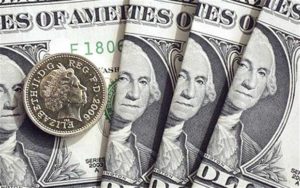 Yesterday’s trade saw GBP/USD within the range of 1.5301-1.5382. The pair closed at 1.5350, going up 0.24% on a daily basis, following four consecutive trading days of losses. The daily low was a test of Fridays low and has also been the lowest level since October 14th, when the cross registered a low of 1.5244.
Yesterday’s trade saw GBP/USD within the range of 1.5301-1.5382. The pair closed at 1.5350, going up 0.24% on a daily basis, following four consecutive trading days of losses. The daily low was a test of Fridays low and has also been the lowest level since October 14th, when the cross registered a low of 1.5244.
At 8:05 GMT today GBP/USD was down 0.05% for the day to trade at 1.5346. The pair touched a daily low at 1.5341 at 7:58 GMT, trading in a tight range.
Today the cross may be influenced by a number of macroeconomic reports as listed below.
Fundamentals
United Kingdom
Gross Domestic Product – preliminary estimate
The preliminary estimate of United Kingdoms GDP probably showed that economy expanded at a rate of 2.4% during the third quarter of 2015 compared to the same period a year ago. If so, this would match the final GDP growth rate in Q2 and would also be the lowest annual rate since Q3 2013, when the GDP expanded at a pace of 1.9%. The Q2 final rate was a revision down from the second GDP estimate, which pointed to a 2.6% growth.
Household consumption expenditure rose at a final rate of 3.1% in the second quarter this year compared to the same period a year ago, while the second estimate pointed to a 3.3% growth. Government expenditure was 1.6% higher in Q2, according to final data, while the second estimate pointed to a 1.9% increase. Gross fixed capital formation increased at a final 3.4% in Q2, slowing down from a 4.9% surge reported previously. At the same time, business investment expanded by a final 5.5% during the period compared to a 5.0% surge in the second estimate. UK exports climbed 2.9% in Q2, slowing down from an 8.1% jump, as reported previously, while the nations imports went up at a final 1.4%, slowing down from a 5.9% increase in the second estimate, the Office for National Statistics said.
On a quarterly basis, the preliminary estimate of UK GDP probably showed a 0.6% growth during Q3 2015, after in Q2 economy expanded at a rate of 0.7%, according to final data, released on September 30th. The final quarterly GDP estimate confirmed the preliminary and the 2nd estimates. It has also been the fastest quarterly rate of increase since Q2 2014, when UK GDP expanded at a final 0.9%.
In case a slower-than-projected annual rate of growth is reported, this would have a strong bearish effect on the sterling. The preliminary GDP estimate is due out at 9:30 GMT.
United States
Durable Goods Orders
Durable goods orders in the United States probably dropped for a second straight month in September, down at a monthly rate of 1.1%, according to the median forecast by experts. In August orders were 2.3% lower from a month ago, a revision down from a 2.0% drop reported previously. It has been the sharpest monthly decline since December 2014, when orders were down 3.7%.
In August, excluding transportation, new orders remained virtually unchanged. Without taking into account defense, new orders slumped by USD 2.2 billion (1.0%) from a month ago. Transportation equipment, also down in August after two straight months of increases, dropped the most, by 5.8% to reach USD 78.7 billion.
Shipments of manufactured durable goods were virtually unchanged at USD 243.2 billion in August, after a 1.0% climb in July. Unfilled orders for manufactured durable goods dropped by USD 2.2 billion (0.2%) to reach USD 1,195.3 billion, following a 0.2% gain in July. Inventories of manufactured durable goods were almost unchanged at USD 401.4 billion, while non-defense new orders for capital goods slumped by USD 1.6 billion (2.0%) to reach USD 80.4 billion in August, according to data by the US Census Bureau.
Durable goods orders, as an indicator, gauge the strength of US manufacturing sector and represent a major portion of the nations factory orders. This is a closely watched report on manufacturing activity, because durable goods are the first type of goods to be affected by an economic downturn or upturn.
Durable goods are designed to last three or more years and encompass aircraft, automobiles and buses, cranes, machine parts, appliances etc. More than 85 industries are represented in the sample, which covers the entire United States. The logic behind this indicator is that consumers need to be very optimistic in order to buy an automobile in comparison with, for example, first necessities such as food or clothing. Therefore, durable goods are among the first goods, which a consumer may abstain from purchasing, in case overall economic activity begins to contract.
Durable goods orders, which exclude transportation, probably remained flat for a second straight month in September, according to expectations, following four successive months of increases. Large ticket orders, such as automobiles for civil use or aircraft, are not present in the calculation, as their value may be in a wide range. This way the index provides a more reliable information in regard to orders for durable goods.
In case the general index decreased at a faster-than-projected pace, this would have a strong bearish effect on the US dollar. The US Census Bureau is scheduled to release the official report at 12:30 GMT.
Services PMI by Markit – preliminary estimate
Activity in the US sector of services probably remained unchanged in October, with the corresponding preliminary Purchasing Managers Index coming in at a reading of 55.1. It has been the lowest index reading since June 2015, when the PMI stood at a final 54.8. In August the final seasonally adjusted PMI came in at 56.1, up from a preliminary value of 55.2. The PMI is based on data collected from a representative panel of more than 400 private sector companies, which encompasses industries such as transport and communication, financial intermediaries, business and personal services, computing & IT and hotels and restaurants. Values above the key level of 50.0 indicate optimism (expanding activity). In case, however, a slowdown in services sector activity is reported, this would have a moderate bearish effect on the US dollar. The preliminary data by Markit Economics is due out at 13:45 GMT.
CB Consumer Confidence Index
Confidence among consumers in the United States was probably little changed in October, with the corresponding index coming in at a reading of 102.9, according to expectations, from 103.0 in September. The latter has been the highest index value since January, when the gauge was reported at 103.8.
This indicator measures the level of individuals confidence in the US economic development. It is considered as a leading indicator, as it gives an early insight into consumer spending, which accounts for most of the nations GDP.
The index has 1985 as a base year, when the base value was 100. This year was chosen, as it was neither a peak nor a bottom. The Consumer Confidence Index (CCI) is calculated on the basis of a household survey, which reflects consumers opinion on current conditions and future expectations regarding the US economy. Opinions on current conditions account for 40% of the index, while expectations of future conditions account for the remaining 60%. The surveys objective is to define consumer attitudes and buying intentions, while the data are filtered by age, income and region.
A sample of 5 000 households in the United States serves as a basis for the survey. Each month respondents give their opinion based on the answers to five questions: Current business conditions; Business conditions for the next six months; Current employment conditions; Employment conditions for the next six months; Total family income for the next six months. Respondents may answer each question as “positive”, “negative” or “neutral”.
Each of the five questions is given a “relative value”, or the positive responses are divided by the sum of the positive and negative responses. The relative value is then compared against each relative value from the base year (1985). The comparison of the relative values leads to the “index value” for all five questions. These index values are then averaged in order to form the value of the CCI.
In case the index fell more than anticipated, this would have a strong bearish effect on the US dollar, as lower confidence suggests a lower willingness to spend and, respectively, a slower economic growth. The Conference Board research group is to publish the official index reading at 14:00 GMT.
Bond Yield Spread
The yield on UK 2-year government bonds went as high as 0.608% on October 26th, or the highest level since October 12th (0.636%), after which it closed at 0.570% to lose 0.001 percentage point compared to October 23rd. It has been the sixth drop in the past eleven trading days.
The yield on US 2-year government bonds climbed as high as 0.650% on October 26th, or the highest level since October 9th (0.657%), after which it closed at 0.641% to lose 0.004 percentage point compared to October 23rd. It has been the seventh drop in the past eleven trading days.
The spread between 2-year US and 2-year UK bond yields narrowed to 0.071% on October 26th from 0.074% on October 23rd. The October 26th yield spread has been the lowest one since October 20th, when the difference was 0.055%.
Meanwhile, the yield on UK 10-year government bonds soared as high as 1.879% on October 26th, or the highest level since September 22nd (1.882%), after which it slid to 1.824% at the close to lose 3.8 basis points (0.038 percentage point) compared to October 23rd. It has been the fifth drop in the past eleven trading days.
The yield on US 10-year government bonds climbed as high as 2.085% on October 26th, after which it slipped to 2.055% at the close to lose 3.2 basis points (0.032 percentage point) compared to October 23rd. It has been the sixth decrease in the past eleven trading days.
The spread between 10-year US and 10-year UK bond yields widened to 0.231% on October 26th from 0.225% on October 23rd. The October 26th yield difference has been the largest one since October 16th, when the spread was 0.235%.
Daily and Weekly Pivot Levels
By employing the Camarilla calculation method, the daily pivot levels for GBP/USD are presented as follows:
R1 – 1.5357
R2 – 1.5365
R3 (range resistance) – 1.5373
R4 (range breakout) – 1.5395
S1 – 1.5343
S2 – 1.5335
S3 (range support) – 1.5328
S4 (range breakout) – 1.5305
By using the traditional method of calculation, the weekly pivot levels for GBP/USD are presented as follows:
Central Pivot Point – 1.5374
R1 – 1.5447
R2 – 1.5579
R3 – 1.5652
S1 – 1.5242
S2 – 1.5169
S3 – 1.5037





